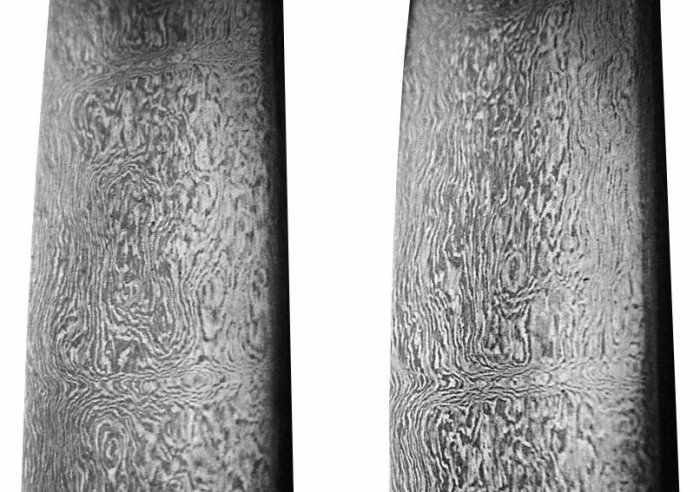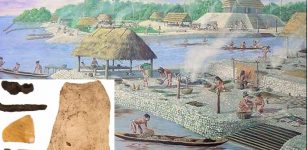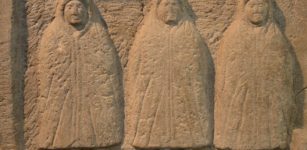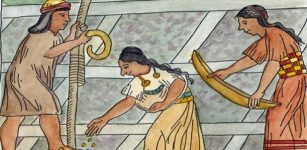Ancient Secrets Of The Damascus Steel – Legendary Metal Used By Crusaders And Other Warriors
Ellen Lloyd - AncientPages.com - When the Crusaders reached the Middle East in the 11th century, they discovered swords made of a metal that could slice a hair in half in mid-air, and yet it was strong enough to strike fear into even the bravest and most persistent warrior.
A shamshir (Persian/Iranian sword with a radical curve. The Royal Armoury, Stockholm, Sweden. Unknown author - LSH 77113 - Public Domain
Knowledge of the legendary metal spread, and it became known to the Europeans as the Damascus steel, named after the capital of Syria. Sometime in the 18th century, the formula for Damascus steel was lost, and the original method for producing Damascus steel remains an ancient secret.
Through the ages, armorers who made swords, shields, and armor were rigidly secretive regarding their method, and the formula of the Damascus steel was only known to a few persons.
Many modern attempts have been made to reproduce the metal, but no one has succeeded due to differences in raw materials and manufacturing techniques.
Damascus Steel And Its Remarkable Characteristics
From around the fourth century A.D., Damascus steel was manufactured in several regional locations. The swords produced with Damascus steel were extraordinary because the blades remained devastatingly sharp through battle after battle.
The Damascus steel gave rise to many legends, such as the ability to cut through a rifle barrel or to cut a hair falling across the blade. According to Dr. Helmut Nickel, curator of the Arms and Armor Division of the Metropolitan Museum of Art in New York, legend had it that the best blades were quenched in "dragon blood."
The swords were easily recognized by a characteristic watery or" damask" pattern on their blades." Damascus steel was not only a remarkable feat of engineering but also a thing of aesthetic beauty.
The metal was derived from Wootz, a type of steel originating in India unusually rich in carbon.
Based on archaeological evidence, it has been determined that the production fit the steel started in present-day Tamil Nadu before the start of the Common Era.
 Watered pattern on iranian sword blade. Close-up of an 18th-century Persian-forged Damascus steel sword. Image credit: Rahil Alipour Ata Abadi - GFDL
Watered pattern on iranian sword blade. Close-up of an 18th-century Persian-forged Damascus steel sword. Image credit: Rahil Alipour Ata Abadi - GFDL
The Arabs introduced the Indian wootz steel to Damascus, where a weapons industry thrived. Wootz steel was highly prized across several regions of the world over nearly two millennia, and one typical product made of this Indian steel came to be known as the Damascus swords.
From the 3rd century to the 17th century, India was shipping steel ingots to the Middle East.
Lost Knowledge Of The Damascus Steel Formula
By 1750, the production of Damascus swords gradually declined, and the process was lost to metalsmiths.
Why the swords were no longer produced is still a mystery. It has been suggested that Damascus steel production declined because firearms replaced blades, and there was less demand for metal. Another option is that the knowledge of the Damascus steel formula was only known to a small group and thus lost with time. Swordmakers succeeded in concealing their techniques from competitors and posterity.
It is also possible that the trade routes supplying Wootz from India were disrupted or that raw material supplies no longer had the same essential characteristics.
Modern Attempts To Re-Create Damascus Steel
A significant problem in scientific experiments on Wootz Damascus steel is the inability to obtain samples for study. Such a study requires that the blades be cut into sections for microscopic examination, and small quantities must be sacrificed for destructive chemical analysis.
A sword maker of Damascus, Syria. Image source
When researchers at the Technical University of Dresden used X-rays and electron microscopy to examine Damascus steel, they discovered the presence of cementite nanowires and carbon nanotubes. The study showed that these nanostructures are a result of the forging process.
Jeffrey Wadsworth and Oleg D. Sherby, two metallurgists at Stanford University, may have unraveled the mystery of the Damascus steel. According to Dr. Wadsworth, as suspected by several early metallurgists, an essential requirement is a very high carbon content.
Dr. Wadsworth and Dr. Sherby believe it has to be from 1 to 2 percent, compared to only a fraction of 1 percent in ordinary steel. Another critical element in Damascus blade production is forging and hammering at relatively low temperatures - about 1,700 degrees Fahrenheit. After shaping, the blades were reheated to about the same temperature, then rapidly cooled, as by quenching in a fluid.
"Modern Damascus" is made from several types of steel and iron slices welded together to form a billet, and currently, the term "Damascus" (although technically incorrect) is widely accepted to describe modern pattern-welded steel blades in the trade. The patterns vary depending on how the smith works the billet. The billet is drawn out and folded until the desired number of layers is formed. To attain a Master Smith rating with the American Bladesmith Society, it is necessary to forge a Damascus blade with a minimum of 300 layers.
Recreating Damascus steel is a subfield of experimental archaeology. Many have attempted to discover or reverse-engineer the process by which it was made, and several researchers have come a long way, but to completely reproduce the process has so far not been possible.
Damascus steel is, without doubt, magnificent art and cutting-edge technology that may be lost to humankind forever.
Written by Ellen Lloyd – AncientPages.com
Updated on Aug 13, 2023
Copyright © AncientPages.com All rights reserved. This material may not be published, broadcast, rewritten or redistributed in whole or part without the express written permission of AncientPages.com
Expand for referencesReferences:
Wes Sander, Intermediate Guide to Bladesmithing
More From Ancient Pages
-
 Location Of Elusive Spanish Fort Is Now Verified By Florida And Georgia Archaeologists
Archaeology | Apr 24, 2020
Location Of Elusive Spanish Fort Is Now Verified By Florida And Georgia Archaeologists
Archaeology | Apr 24, 2020 -
 Sacred Healing Earth Of Chimayo And The Mysterious Black Christ Crucifix
Featured Stories | May 24, 2019
Sacred Healing Earth Of Chimayo And The Mysterious Black Christ Crucifix
Featured Stories | May 24, 2019 -
 Has AI Found An Unknown Human Ancestor?
Archaeology | Jan 17, 2019
Has AI Found An Unknown Human Ancestor?
Archaeology | Jan 17, 2019 -
 Nebuchadnezzar II – Greatest Ruler Of Ancient Babylonia And Conqueror Of Judah
Featured Stories | Jan 28, 2019
Nebuchadnezzar II – Greatest Ruler Of Ancient Babylonia And Conqueror Of Judah
Featured Stories | Jan 28, 2019 -
 Mysterious Ancient Underwater Structure Beneath MacDonald Lake Reveals Traces Of A Lost Civilization In Ontario
Civilizations | Nov 15, 2018
Mysterious Ancient Underwater Structure Beneath MacDonald Lake Reveals Traces Of A Lost Civilization In Ontario
Civilizations | Nov 15, 2018 -
 Discovery Of 1500-Year-Old Celestial Observatory Dated To Sassanian Empire
Archaeology | Mar 16, 2017
Discovery Of 1500-Year-Old Celestial Observatory Dated To Sassanian Empire
Archaeology | Mar 16, 2017 -
 Mystery Of The Hooded Ones – Enigmatic Cloaked Figures
Artifacts | Feb 10, 2020
Mystery Of The Hooded Ones – Enigmatic Cloaked Figures
Artifacts | Feb 10, 2020 -
 Soft Tissue From A 183 Million-Year-Old Jurassic Plesiosaur – Analysed
Fossils | Feb 24, 2025
Soft Tissue From A 183 Million-Year-Old Jurassic Plesiosaur – Analysed
Fossils | Feb 24, 2025 -
 Mysterious Scottish Stone Circles On Orkney Were Used To Something Very Different Than Previously Thought
Archaeology | Sep 24, 2017
Mysterious Scottish Stone Circles On Orkney Were Used To Something Very Different Than Previously Thought
Archaeology | Sep 24, 2017 -
 Tree Rings On the Oregon Coast Show Evidence A Tsunami That Struck The Pacific Northwest In 1700
Archaeology | Sep 3, 2021
Tree Rings On the Oregon Coast Show Evidence A Tsunami That Struck The Pacific Northwest In 1700
Archaeology | Sep 3, 2021 -
 Why Was Ayllu Very Important For The Inca People?
Ancient History Facts | Feb 19, 2019
Why Was Ayllu Very Important For The Inca People?
Ancient History Facts | Feb 19, 2019 -
 Barbarians Were People Who Didn’t Speak Greek
Ancient History Facts | Jan 18, 2016
Barbarians Were People Who Didn’t Speak Greek
Ancient History Facts | Jan 18, 2016 -
 Extraordinary Gold Treasures Found In A Thracian Warrior’s Grave Near Topolovgrad, Bulgaria
Archaeology | Aug 26, 2024
Extraordinary Gold Treasures Found In A Thracian Warrior’s Grave Near Topolovgrad, Bulgaria
Archaeology | Aug 26, 2024 -
 On This Day In History: Maltese Rebellion Took Place – On Sep 8, 1775
News | Sep 8, 2016
On This Day In History: Maltese Rebellion Took Place – On Sep 8, 1775
News | Sep 8, 2016 -
 Why Did Vikings Hide A Precious Silver Treasure Under The Thralls’ House?
Archaeology | Sep 18, 2024
Why Did Vikings Hide A Precious Silver Treasure Under The Thralls’ House?
Archaeology | Sep 18, 2024 -
 23,000-Year-Old Footprints Are Earliest Evidence Of Human Activity Found In The Americas
Archaeology | Sep 23, 2021
23,000-Year-Old Footprints Are Earliest Evidence Of Human Activity Found In The Americas
Archaeology | Sep 23, 2021 -
 Illuminati: Facts And History About The Secret Society
Featured Stories | Mar 30, 2017
Illuminati: Facts And History About The Secret Society
Featured Stories | Mar 30, 2017 -
 Bizarre Devil’s Tramping Ground In North Carolina Is Avoided By People And Animals
Featured Stories | May 1, 2019
Bizarre Devil’s Tramping Ground In North Carolina Is Avoided By People And Animals
Featured Stories | May 1, 2019 -
 Chagyrskaya Female Neandertal That Lived 60,000-80,000 Years Ago – Studied
Archaeology | Jun 23, 2020
Chagyrskaya Female Neandertal That Lived 60,000-80,000 Years Ago – Studied
Archaeology | Jun 23, 2020 -
 Restoration Of Valuable 4th Century Silk Tunics Attributed To St. Ambrose Takes Place In Milan
Artifacts | Apr 12, 2017
Restoration Of Valuable 4th Century Silk Tunics Attributed To St. Ambrose Takes Place In Milan
Artifacts | Apr 12, 2017


